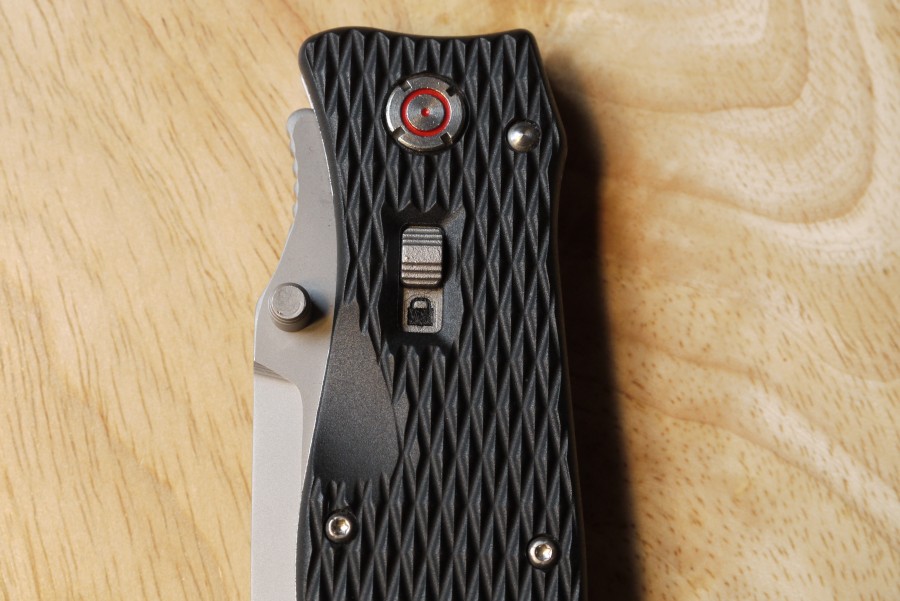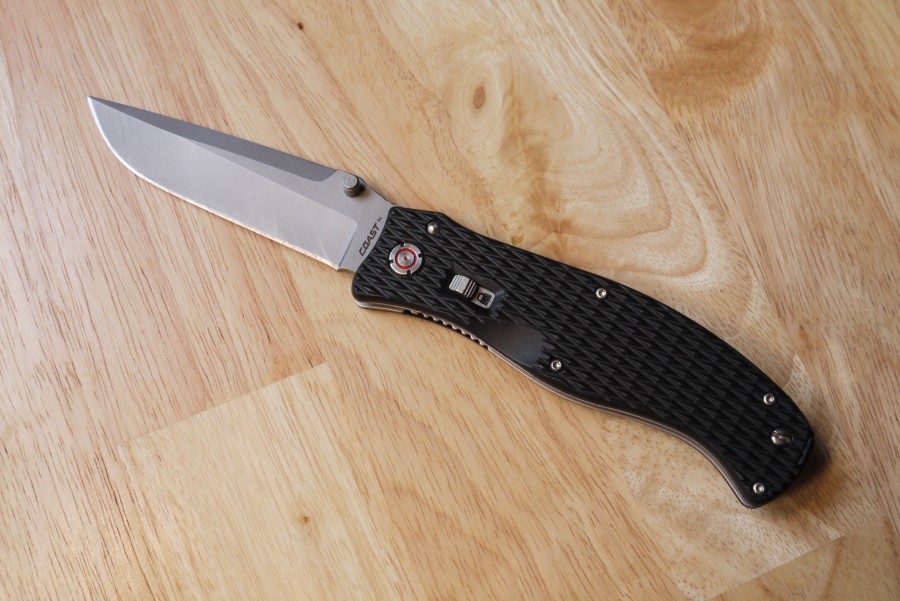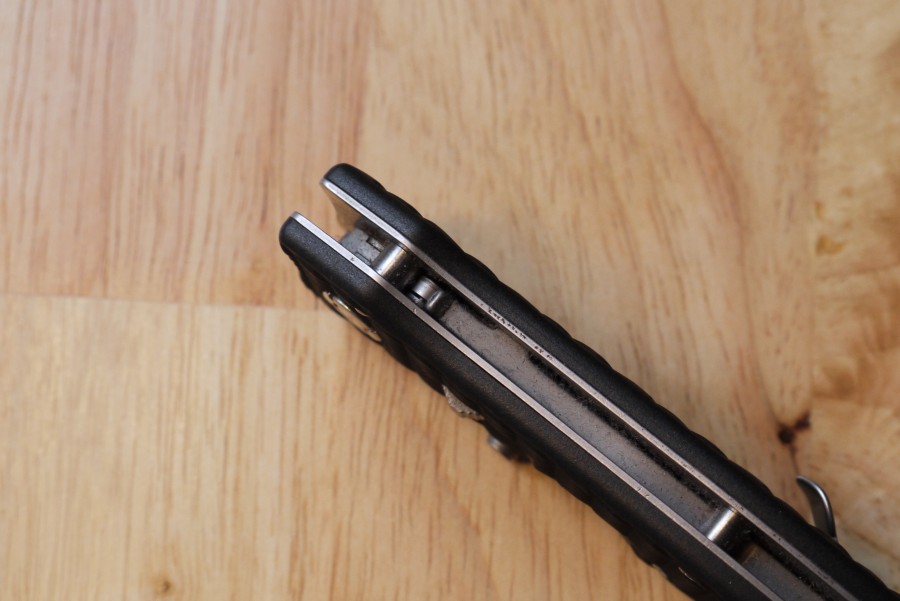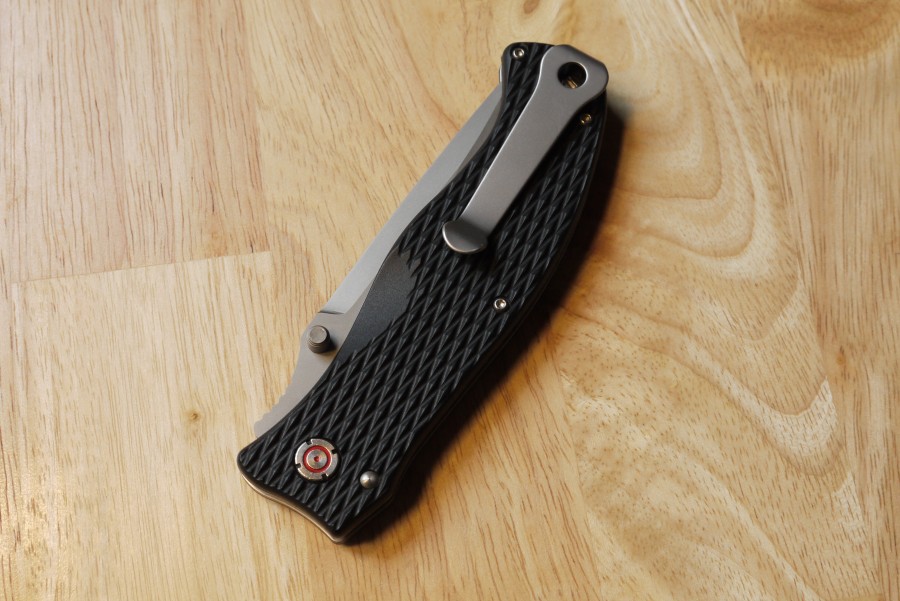RF’s vacation starts today. He might post, but he’s sure as hell not checking the content as often as he usually is. Which means hopefully I can slip in a non-firearms (yet firearms related) review of a product I ran across at SHOT this year: the Coast Rapid Response 3.90 Knife.
Knives generally aren’t my thing. I’m a gun guy, and they’re my tool of choice when it comes to self defense. But with my side job as an EMT there have been a number of times where having a knife handy makes all the difference. I can remember one incident shortly before I left Fairfax where we had to cut a drunk driver out of his clothes to assess a heavily bleeding wound and having my knife handy saved us a good 30 seconds of poking around the bag for the trauma shears. It also helped with the hanging woman, but we won’t go into that one.
The point is that a sharp and reliable blade is something that I’ve come to include in my daily loadout. Every morning I grab my watch, my wallet, cell phone, keys, knife and gun off the nightstand and walk out into the world ready to face any challenge. Considering my hobbies (shooting and pulling people out of car wrecks) I have a pretty high standard when it comes to the cutlery I carry. So when I ran across the guys at Coast (full disclosure: I originally only stopped by their booth for the free beer) and they told me about their new “Rapid Response” knives I had to try one out. So they handed me one right then and there and I’ve been carrying it ever since.
There are a few features about this knife that make it stand out to me. The first of which is the manual safety on the side of the knife.

When I was at SHOT it had only been a few weeks since I had gone out and become the scourge of the wildlife on Tyler’s ranch in Texas. I learned many things that weekend, the most interesting of which was how to field dress a deer.
For the uninitiated, “field dress” is a euphemism for disemboweling the freshly killed animal in an effort to preserve the meat. It involves opening the abdomen, splitting the sternum, cracking open the pubic symphysis and slicing out the internal organs of the animal. In order to accomplish the task you need a very sharp and very durable knife (and possibly a sawsall). Tyler had a trick for cracking open the cartilage that involved using the back of the knife blade as a wedge, but that made me slightly nervous that the knife was going to snap closed on his fingers.
The manual safety on this knife acts as a backup to the standard locking mechanism, providing a little extra piece of mind when you need it. And if you don’t want to use it you don’t have to. But there’s another reason I like the manual safety: the assisted opening mechanism.
I had never seen an assisted opening knife before SHOT, but after the show I felt like I had sat through a graduate course on the things. Assisted opening knives seem to be the “new thing” that knife manufacturers are building into their stuff, and the basic principle is that the user opens the knife just a tiny bit and then an internal spring automatically opens it the rest of the way. It’s a legal loophole around the switchblade laws, and while I never felt that I absolutely needed that feature on my knife it does make opening the knife a little easier.
The only problem is that I had a small obsession with the idea that the knife was going to get snagged on something, open up in my pocket and slice the crap out of my leg. But thanks to the manual safety that idea was put to rest.
The other thing I liked about the knife is the profile of the blade. Some knives come with a crazy curving blade that’s impossible to sharpen using my old Boy Scout issue sharpening stone, but the Coast knife uses a simple straight main cutting surface with a gently sloping curve towards the tip.
There are, however, some issues with the knife.
The pocket clip leaves a little to be desired. I may have been spoiled by Benchmade’s flawless pocket clip design, but this one is a little tough to unhook from my station pants when I’m in a hurry. Which is just about every time I need the thing.
Complaint #2 is about the durability of the blade. I’ve just recently moved to Texas, so I figured the perfect test of this knife was to use it to cut up all the cardboard boxes. It made it through about half of them while still razor sharp, but then it lost its edge. My Benchmade opened and destroyed an identical number of boxes but kept its razor sharp edge to the end. Admittedly it didn’t last much longer and both knives have needed a sharpening, but it’s the little differences that matter the most.
The last issue I had was that the knife is a little too long for my taste. It clocks in at just barely under 4 inches, which makes it the longest folding knife I’ve ever owned. I asked for that on purpose — I wanted to try it out and see if I liked the small ones or the large ones better. And it turns out that I like the small ones. But never fear: Coast makes a smaller version of this very knife that is nearly identical and probably closer to my ideal length.
So what’s the verdict? Well, when you consider the totality of the evidence I still think it’s a fine knife for the money. It has some nifty features, and at $44 MSRP it’s not going to break the bank. If you’re looking for a good general purpose knife this definitely warrants a peek.
And that’s why I love the SIG SAUER P226.
Coast Rapid Response 3.90 Knife
MSRP: $44
Overall Rating: * * *
Not the “perfect” knife, but good enough.
http://www.coastportland.com/rapid-response-3.90.htm








That’s a pretty scary looking knife there, sonny. You shouldn’t be allowed to own such an offensive weapon without a good reason you know. How many cardboard boxes have to be stabbed before we stop the madness?
For my part,
Assisted open + manual lock = Solution in search of problem.
If assisted open is supposed to help with deployment speed, why add self-defeating manual safety?
Proper blade balance + smooth pivot = Fast deployment
and
Proper backlock = Safe retention
Example: Spyderco Delica/Endura
Awesome review though. Let’s increase the knife dialogue on this blog.
#1
I would like to see far more knife reviews here too.
Take a look at some of CRKTs knives, especially in the “M16” line (M21, others). Stout folders with locks, various blade profiles available, and the assisted opening is by a flipper that forms a small hilt when the blade is open. That’s Columbia River Knife and Tool.
+1 on CRKT
I have an M21 and a minimalist,
both are great knives.
Ditto on the CRKT M-16. On my 3rd one (one at bottom of lake,then purchased one with a tanto point which I didn’t like for EDC, and then I bought my current clip point which has served 3 years now of EDC). At $40 new, it is a great knife and doesn’t hurt too bad if you lose it in a lake.
Another +1 for CRKT
I received a CRKT Van Hoy Yea-Go for christmas this year and was blown away by the assisted opening mechanism. Super sharp blade and a nice liner lock have made it a welcome friend in my pocket.
I’ve carried the M21 for about five years. I use my knives very hard. Like moving around large motors while aligning pulley systems, cutting on all sorts of cords and ropes up to and including copper wire, many, many, many bits of cardboard and sometimes even deburring conduit. This knife has served me well, but like most material removal designs, it’s only surface hardened. I’m through that surface now and the knife will no longer hold an edge.
For the price, I’ll just buy another one.
I absolutely love the CRKT M21 but the steel (AUS 8) whilst being easy to sharpen & great for cutting game & most other stuff also loses its edge pretty fast when cutting cardboard boxes. Those damn boxes are surely one of the worst materials for removing a knife’s edge & I have to deal with several on a daily basis.
The 420HC steel Buck use in their Rangers keeps its edge longer but oh boy, is it a pain to sharpen & the blade shape isn’t what I want for every day use.
I liked the P226 plug at the end. That should help satisfy RF a little lol.
I believe that was an inside reference to an old rule at thetruthaboutcars.
For a pocket knife, I generally don’t care how “long” the blade stays sharp – even the cheapest of the cheap can hold an edge long enough to get through 99% of the tasks that I’ll use a pocket knife for (box cutting isn’t one of them, that’s what box cutters are for 🙂 ). What is important to me is how well a blade will take an edge. I usually end up sharpening my pocket knives on a monthly/bimonthly basis (as needed) anyway.
Kershaw Leek is one of the sharpest knives I own. I do not know what they do to them but the edge is fantastically sharp and stays that way for a long time
If it keeps the edge for a long time that probably means that it is a hardened steel that received a higher quality heat treatment. When steel reaches certain specific temperatures the molecular structure changes. Then depending on how quickly the metal is cooled the structure will reform in various ways. Combining different heating and cooling processes result in a large variety of metal characteristics, too numerous to list here. Typically harder steels require more time or heat, thus increased cost. Isn’t metalurgy fun!? http://en.wikipedia.org/wiki/Heat_treating
The harder you temper the steel the more brittle it becomes and the harder it is to resharpen. So it’s a trade off. Cheap steels will take an edge easily, but dull quickly. And if hardened too much will chip under hard use. Which helps explain the cost differential between two very similar knives, one going for most of a Benjamin while the other is a 9.99 WalMart special. It’s the steel stupid.
Plus is you want them to resharpen it, just mail it to them – it comes back like a razor for around $4!
Two knife stories on the front page? You should change the masthead to read, “The Truth About Knives”.
Love to see RF’s face when he logs in and sees that.
I always carry my Kershaw Skyline at work (also an EMT) and it has never let me down. It’s a manual flipper design, one-handed opening, light, and thin. I’ve had it over a year and it hasn’t let me down. Good review though.
‘use it to cut up all the cardboard boxes’
Have some respect for the dead. Those boxes are paper products and that means they come from wood which in turn comes from once-living trees. Those boxes are the children of the tree spirits. What have trees ever done to harm you? They are all innocent I tell you! Innocent! Those trees even gave you oxygen to breathe so you can live and look how you have shown your gratitude. The only reason that you take such joy in poking into and cutting up boxes (and your shooting hobby too) is to compensate for the love and intimacy you are lacking in your own life.
I have a SOG with the manual safety. It got in the way more than anything so I ended up using superglue to permanently un-safe it.
Nice little review. I’m just wondering, however, how many of the readers will understand “pubic symphysis” on first read. As a former EMT, I know the terminology, but I doubt the ordinary reader does.
IMHO – that’s ok. I always have considered making others expand their vocabulary to be a good thing. But I had to chuckle nonetheless.
You might want to add flashlight to that stuff you you carry everyday. I carry your list plus an E2D. I’ve been surprised at how many times it has been just what was needed. Seeing can sometimes be important. Then again, I’m a half-blind old fart who can’t hear out of one ear and is deaf in the other.
Might look at the Maglite XL2000. It’s not as bright as Surefire (only 172 lumens versus the 200+ most other flashlights have) and does have some…eccentric controls (still follows basic on/off switch principles with no issue, the eccentric stuff is extraneous). But it runs off of AAA batteries, which are a lot cheaper than those damn replacements commonly found in high-lumen flashlights.
Coast also makes some very solid LED flashlights that get tremendous brightness and battery life out of ordinary rechargeable AAAs.
I’d be more interested in some reviews of new products by Kershaw, Benchmade, and Spyderco. Coast, not so much, especially since they don’t seem to want you to know what blade steel they use.
I carry a Ka-Bar Dozier folding hunter due to its small size and weight. It might not be a extremely beefy knife, but I definitely trust a lock back over a liner lock.
Many knives have come and gone in my life but none hit the spot like my Spyderco Endura 4. Tough as hell, strong lockback, great traction pattern on the handle and VG-10 is among my favorite steels. VG-10 takes a bit more time to get sharp but once it’s there its in for the long haul. I haven’t bought a new knife in probably five years because I like the Endura so much.
In my experience knives that don’t list the steel are almost always a lower grade 440. 440C is decent and will take a wicked edge in a jiffy but dulls too quickly for my taste. AUS-8A is a decent compromise and S30-V is the toughest I’ve ever used. Also, every knife owner should at least check out the Spyderco Sharpmaker. A paper-slicing edge is only minutes away with one.
Unfortunately, assisted opening knives remain illegal in Washington, so no joy for this particular model. I carry a Benchmade, but I don’t know the model. The training center based out of the range I go to has some defensive knife classes I want to take at some point. It’s not in my plans to make a knife my primary means of defense, but I definitiely plan to have it in the tool kit in case I can’t have my gun with me or as a close-in, last-ditch weapon.
@Carlos:
We’re almost there! The WA state house and senate both passed a bill to legalize assisted-opening knives last week. You can check the progress of the bill as it awaits the Governor’s signature here:
http://apps.leg.wa.gov/billinfo/summary.aspx?year=2012&bill=2347
Or you can check the website of Governor Christine Gregoire. I don’t know why she hasn’t signed it yet, but I believe she only has 5 days to veto it or it becomes law after 90 days anyway.
I’m waiting to review a slightly-smaller 3-inch Rapid Response myself, along with a nifty multi-tool with built-in LED worklights.
Mmm…gear…mmm….
Chris, read the text of that bill as passed and sent to the governor for signature: it doesn’t do a lot for the average citizen. Basically, it authorizes law enforcement, firefighters, rescue workers, and military users to carry them on duty, and protects manufacturers who are working with law enforcement and military. Otherwise, assisted opening knives are still prohibited.
The new law allows assisted openers, but not automatic knives. It redefines ‘spring blade knife’ to exclude most assisted openers, including the Rapid Response. Assisted openers (as opposed to true switchblades or automatics) have an opening mechanism applies a ‘bias toward closure’ which holds the blade closed until force is applied to overcome that bias toward closure.
The language is a bit awkward, but it was proposed by the knife companies themselves. Firefighters and law enforcement can now carry true automatic knives under the new law.
Oh, so it’s this language that’s the good bit?
That’s one of the nice things about the CRKT M-16/M-21 series. The “assisted opening” is simply a lever (they call it a “Carson flipper”), and no springs are involved.
I am giving up on folders in favor of Fixed blades. Lighter, stronger, feel better in the hand, deploy faster. The only downside is the need to carry a sheath.
Love my cheap Spyderco Chinese folders though. Folders much over three inches don’t make a lot of sense to me.
Many states completely prohibit the discreet carry of fixed-blade knives.
List them.
@Leghorn
If you are having trouble with the clip being to tight on your pants, take something hard and slip it into the clip. Then gently put it up some to create a gap between the clip and the rest of the knife. It will still stay on your pants pocket very well, but you won’t need to tug at it to get it out.
Gibbs’ rule #9,
“Never go anywhere without a knife.”
Thanks for the helpful review.
They don’t say what steel they’re using in this particular knife.
Most quality knives that are using stainless use at least American 440C stainless. This was the start of a run of newer knife steel metallurgy. 440C, however, is now “obsolete” in higher-end knives.
My Benchmade blade is made from 154CM steel, which is a proprietary steel made by the Crucible Steel company. It holds an edge longer and has better hot hardness than 440C.
When I see any knife company say that they make their knives from “400 series” stainless steel(s), that tells me that they’re probably taking the cheap route. They’re likely using 440A or Chinese 440C. Where steelmaking is concerned, the Chinese make crap. Period, full stop, end of story. Chinese steel is crap. Chinese stainless steel is crap. The only redemption that Chinese metallurgy has is that it is cheap. That’s it. After that, it’s all negatives – it doesn’t matter whether we’re talking cold rolled low carbon steel (1018), or high speed tool steel in machine tooling, or stainless steel. It’s all cheap crap.
The steels I require in a carry knife are either ATS-34 or 154CM. Of those, I prefer 154CM first, ATS-34 second. They both have superior edge-retention over real (ie, American-made) 440C stainless.
There’s a new steel for knife blades on the market called S30V, which is a powdered metal that is much tougher than 154CM, but since so many people here have a snit fit about MIM technology, I’ll assume that they’re not interested in another powdered super-steel.
Here’s the technical data on S30V for those who are:
http://www.crucible.com/PDFs%5CDataSheets2010%5CdsS30Vv1%202010.pdf
Oh, cool! I just looked at my Benchmade I saw it has a little S30V by the thumb stud. Nifty.
S30V has actually been around for many years but it is tough as all get out. I have a special edition Kershaw Leek that uses it and that sumbitch takes forever and a day to get dull. Sintered metal for a knife blade is an entirely different beast than MIM in gun parts.
Really? How is MIM different than powdered metal production where the material properties are concerned?
From what I see from gun nuts and their discussion of MIM, they might as well be saying “That part was made by witchcraft, and I shall have no foul work of the Devil in my weapon!” for all they actually *know* about MIM.
I guess I should have been more clear. What I was trying to convey was that the alloys for knives versus gun parts are quite different (using expensive S30V for a 1911 thumb safety is unnecessary) so fellas that don’t trust MIM gun parts shouldn’t automatically discount a fine steel like S30V. I personally don’t understand the negative fuss towards MIM and have zero problem with it be it in a knife or a gun.
Where are they made? Since Fiskars bought Gerber many of them are Hecho en Chine, not cool.
coast makes great flashlights..I wonder if they all left gerber, also in portland.
Comments are closed.